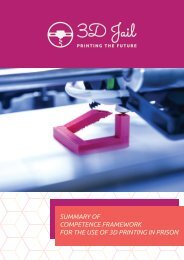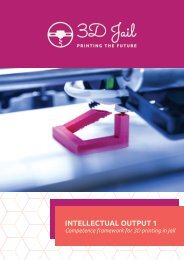Training models for the use of 3D printing technology in prison
3D Jail project further involves a training program for the training and development of trainers who are going to deliver the training program for inmates. Trainers are required to have basic computer, CAM and CAD skills. For the training of the trainers has also been planned an in-service training program to cover information on general characteristics of penitentiary institutions and inmates, use of the e-learning portal, and 3D printing.
3D Jail project further involves a training program for the training and development of trainers who
are going to deliver the training program for inmates. Trainers are required to have basic computer,
CAM and CAD skills. For the training of the trainers has also been planned an in-service training
program to cover information on general characteristics of penitentiary institutions and inmates, use
of the e-learning portal, and 3D printing.
You also want an ePaper? Increase the reach of your titles
YUMPU automatically turns print PDFs into web optimized ePapers that Google loves.
●
●
●
hiring instructors and staff who are comfortable with technology and regularly training them
on technology advancements and security procedures;
providing instructors with restricted Internet access in the classroom; and
creating a collection or repository of resources that both meet security standards and enable
and encourage collaborative learning.
INFRASTRUCTURE
All students and educators will have access to a comprehensive infrastructure for learning when and
where they need it.
To achieve this goal in correctional education, we recommend using advanced technologies to
●
●
●
adopt mobile devices (e.g., tablets) that allows students to learn both inside and outside of
the classroom;
support the education continuum by ensuring that the education services students receive
while incarcerated are aligned with community-based services; and
provide a seamless transition for students as their correctional status changes by sharing data
(e.g., transcripts, credits, and assessment scores) with other facility- and community-based
programs.
The implications for policy and practice include
●
●
●
permitting students to use mobile devices both in and outside of the classroom;
providing facility-based instructors with educational technology tools that are similar to those
available in community-based programs to ensure that curricula and instructional practices
are well aligned; and
creating data-sharing agreements among facility- and community-based education providers.
PRODUCTIVITY
Our education system at all levels will redesign processes and structures to take advantage of the
power of technology to improve learning outcomes while making more efficient use of time, money,
and staff.
To achieve this goal in prison education, we recommend using advanced technologies to
●
●
●
expand the reach of prison education services to provide more incarcerated individuals with
the knowledge and skills needed to obtain living-wage employment, become productive
members of society, and exit court supervision upon release;
track educational attainment and post-release outcomes to determine the effects of prison
education on job placement and retention, college transitions and persistence, and recidivism;
and
support non-education functions and activities at the facility to help mitigate cost.
The implications for policy and practice include
●
determining what level of advanced technologies are appropriate for different facilities, types
of offenders, and security levels;
3DJail printing the future – IO2
12





